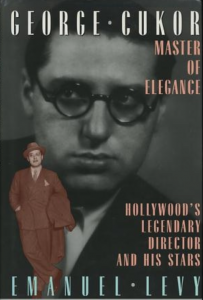The two men talked about the good old plays in a casual manner, and The Corn is Green came up. Later that year, Cukor called Williams and told him he was interested in doing his play with Hepburn. The playwright was, of course, ecstatic.
For once, it was not hard to get a studio backing for the project. “Warners respected George enormously,” Cukor’s agent Ben Benjamin said, “and they wanted to establish prestigious TV movies: The Corn is Green was a famous play and a famous movie too.” Cukor was praised by his colleagues for saying out loud, “What’s wrong with doing a good TV movie” He was not defensive about moving to television. Dreading the pressure of a feature movie, he went for TV. It was easier and faster to get a TV movie financed and made.
Cukor asked Katharine Hepburn if she would work with him on another TV movie. She reread the play and found it to be hopeful and powerful. It was also politically correct, propagating education of the masses and generosity of spirit–values that Hepburn has stood up for in her movies and in her life.
As Mrs. Moffat, Hepburn played the spinster schoolteacher, who comes to teach in an illiterate Welsh mining village, and discovers that one of her young miner-students has unusual talent.
Hepburn knew it was a great role: Ethel Barrymore played it in New York and Sybil Thorndike in London. Ironically, in the 1946 movie, Bette Davis was too young (36) to play the middle-aged Moffat, and in 1979, Hepburn was too old (70).
Irving Rapper shot the 1946 Warner film on the studio lot, but Hepburn suggested doing it in its proper locale, in Wales. She went with Cukor to London and Wales, to search for the right cast and proper location. Cukor didn’t mind traveling; after his harrowing experience in Russia, everything seemed easy.
Though it was their tenth collaboration, Cukor and Hepburn continued to argue, but their arguments were good-natured. “Our relationship is give and take,” Cukor said, “I give and she takes.”
On January 29, l979, when The Corn Is Green premiered on TV, the reviews were far from praising. Cukor’s direction was not as strong or tight as in his first TV movie. Even Hepburn’s work was not lauded. Strangely, she brought no new insights into her part; perhaps she was too comfortable playing it.
Cukor didn’t think the British critics were appreciative of his efforts, but then they seldom were. “They’re inclined to be bitchy,” he told his friends, “I see some crapola British TV, but Americans are generous about it. I suppose we’re too ignorant to know the difference.”
A videocassette of the movie was sent by Cukor to Emlyn Williams, with a note: “It was a thrill to work on such wonderful material. It played.”
Indeed, seeing the TV production was for the writer a lovely experience; he wished the real Miss Moffat could have seen Cukor’s version.











